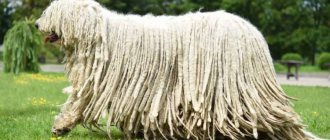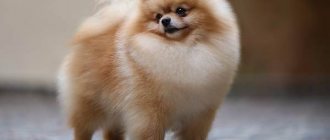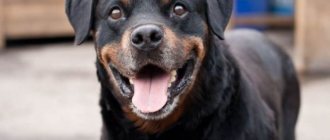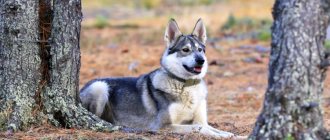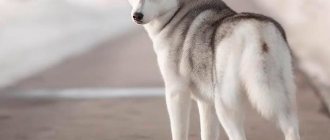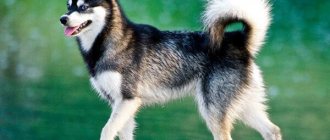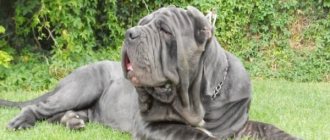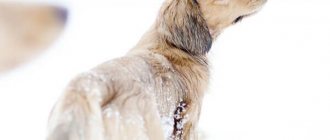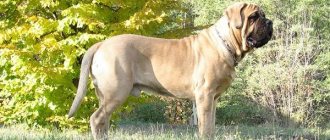- August 29, 2018
- Dogs and hunting with them
- Roman Karpets
Burrowing dog breeds include dachshunds and short terriers, intended for hunting badgers and foxes. All of them are united by small size, endurance, performance, muscle strength and jaw strength. Today's publication will provide brief descriptions of these animals.
Features of education
These dogs, like representatives of any other breeds, must undergo a general training course and learn to unquestioningly execute basic commands, including “Come to me” and “No”. In addition, from an early age they develop the ability to be in a hole and find prey.
With a five-month-old puppy, you can already start training. This should be done gradually and at special stations. Since conducting the first classes in natural conditions is not only difficult, but also unsafe. Before training the dog, it is strictly forbidden to feed it, and when starting it in a hole, you must remove the collar from it.
After the animal has become accustomed and has learned to work in artificially created conditions as a decoy animal, you can proceed to the next stage. Experienced hunters recommend first selecting shallow holes for this purpose that have a small number of branched passages, gradually complicating the task and increasing the duration of the lessons.
Principles of training burrowing dogs
When getting a burrowing dog as a companion, the owner must be prepared in advance that raising the pet will take a long time and patiently. Norniks are independent and self-sufficient, authority must be gained from them, and controllability must be achieved . An ill-mannered dog can run away and get into trouble or attack someone it considers game.
But much more serious efforts will be needed to train working dogs. For a hunting breed, it is not enough to be guided by instinct; you need to be able to implement it correctly. An obligatory part of the comprehensive training of burrowers is the so-called training - baiting a young dog with a real animal, which it will have to hunt in the future.
The training of a burrowing dog should be carried out by experienced specialists.
An important discipline for a novice hunter is also mastering artificial holes. Competitions of burrowing dogs also take place at the same facilities, which are as close to reality as possible.
Professional training begins no earlier than the dog is six months old, depending on its breed and individual abilities. First, the dog learns to find and bark the animal correctly, then it trains on a skin, for example, a fox, to pull prey out of a hole. All successful actions must be encouraged by the owner.
Norfolk Terrier
This is a relatively young breed of burrowing dogs, bred in the territory of the English county of the same name. It was derived from the Scottish Terrier and was officially recognized in 1964.
Norfolk is a small dog, growing to 22 - 25 cm at the withers and weighing about 5 kg. On a wide dome-shaped head with a wedge-shaped muzzle are oval dark eyes and triangular ears tilted forward. Under the elongated body with strong bones and a strong neck are short, straight limbs with gathered fingers and thick pads. The entire body of such a dog is covered with a hard spine with a thick undercoat. As for the color, it can be red, wheaten or black with graying.
Norfolks are excellent burrowing dogs, endowed with the appropriate disposition. They are very energetic, resilient, agile and stubborn. These dogs get along well with children and do not show aggression towards people. They cannot stand loneliness and are easy to train. When walking around the city, they should not be let off a leash, as they may chase a random cat, mistaking it for prey.
Other representatives of hunting breeds
Jomon-shiba
Outwardly it resembles a small Japanese mountain wolf. Known only in Japan. Possesses fearlessness and rage. This is an ideal dog for a hunter due to its natural sense of smell and high level of development of the sense of smell. Parenting is very difficult.
Catahoula Leopard Dog
Recognized as the official symbol of the state of Louisina (USA), it is not known outside its country. Registered in 1995. Height is slightly more than 60 cm. The color of the coat is spotted, reminiscent of a leopard. Suitable for hunters of large and medium-sized wild animals. He has a keen sense of smell, the ability to jump high and cover distances.
Dachshund
A magnificent hunter with an elongated body and short legs. Used for catching badgers and foxes. By nature she is endowed with a keen sense of smell and a ringing bark. Acts as a security guard. Parenting is difficult due to his nimble nature and disobedience. Valued by lovers of burrow hunting.
Tenterfield Terrier
The breed is not officially recognized. Originally from Australia, introduced during the development of the continent as a rat hunter. At the withers it is only 28 cm. He has a good sense of smell and a lively temperament.
Helleforshund
Easily hunts deer. Similar to spitz-shaped representatives. The character is lively, has irrepressible energy. The sizes are average. From the outside they resemble a cross between a husky.
Hortaya greyhound
A very rare breed. Used successfully in remote areas for hunting. Not included in the general classification. The general appearance is similar to greyhounds. It began its development from the times of Kievan Rus. Has not been subjected to selection.
Chukotka sledding
An indigenous breed for working in harness and carrying heavy loads. Helps hunt sea animals and withstand cold weather. Endurance and activity are the main traits of a dog.
Swedish White Elkhound
The breed is called "moose husky". Not classified as a group. A bit like a husky. Snow-white fur makes the dog invisible to the animal in snowy conditions. Considered rare, the population is small.
Skye Terrier
This is a very ancient and fairly common breed of burrowing dogs, bred specifically for hunting foxes and small rodents on one of the Scottish islands that are part of the Hebrides archipelago.
The Skye Terrier is a small dog, growing up to 20.5 cm at the withers and weighing up to 12 kg. The disproportionately large head with a black nose and strong jaws has expressive eyes and erect or drooping ears. The dense, stretched body, under which there are short limbs, is covered with long silky fur of fawn, gray or bluish color.
Skye terriers are one of the best burrowing dogs for foxes and small rodents. Despite their miniature size, they cannot be classified as decorative animals, accustomed to sitting on the owner’s sofa. They are incredibly active, cheerful, resilient and efficient. These kids are distrustful of strangers and will never take a treat from someone else's hands. Plus, they need special training and regular long walks.
Pointing dogs for hunting
Pointers are a group of hunting dog breeds bred to hunt game birds. They work both in open fields and in dense thickets. They track the target using their upper senses. They follow the trail with a stealthy gait, trying not to frighten the bird before making a shot. Having reached their destination, they freeze in one of two stances:
- lift one of the front paws and stretch it forward along with the entire body;
- sit down as close to the ground as possible in the direction of the target.
When the hunter approaches, the dog scares the bird, forcing it to fly, and after shooting it down, it brings it to its owner. Suitable for hunting in swamps and other bodies of water.
Irish Setter
This ultra-sociable and affectionate dog cannot stand being alone. For a comfortable life, the constant presence of the owner is important to him, as well as frequent walks and active games. The excessive intrusiveness of the setter is a given that must be accepted. If close contact with a pet and an active lifestyle are alien to you, choose someone else.
Drathaar
This hunting dog breed has outstanding memory abilities. She quickly masters new commands and does not need long-term skill development.
The drathaar prefers any forays into nature with the aim of catching some kind of game to lying on the sofa. If you are not eager to hunt, give your pet to a group of children. The dog will be happy to join in their catch-up games and other active games.
Weimaraner
Weimaraners are notable for their aristocratic appearance and good disposition. Aggression towards strangers on their part is possible only with outright provocation.
Due to its large dimensions, the Weimaraner is not suitable for families with small children. A dog that gets too playful can injure a child, so the play company should be trusted to school-age children.
Pointer
Recognizes the authority of all family members and willingly follows commands from children. The only condition for a Pointer to be obedient is attention from a person. Thanks to regular communication, joint games and walks, you can quickly win his friendship.
Pointer puppies learn fetch early, but as they grow older they lose interest in it. Because of this, a very small number of pets retain a useful skill.
Cairn Terrier
Scotland is considered the homeland of these animals with a very long history. The first mentions of short-legged burrow dogs, similar in appearance to modern kerns, are found in the records of a bishop dating back to the 1400s. The final formation of the breed was completed many years later, and it received official recognition in 1925.
Kern is a small dog, growing up to 25 - 31 cm at the withers and weighing between 6 - 7.5 kg. On a wide, proportional head with a pronounced stop and strong jaws, there are far-set dark eyes hidden under thick eyebrows and neat pointed ears. The elongated body with a flat topline is covered with coarse red, grey, black or brindle hair with a soft undercoat.
Kerns are active, smart and extremely sociable dogs that require early socialization and serious training. They are distrustful of strangers and do not get along well with other pets. In the absence of proper training, they grow into real little monsters capable of showing aggression.
Hello, daughter!
Meanwhile, Nora’s puppies, who had managed to grow up, were taken from the shelter by other people. All the kids got good homes, and the volunteers were sincerely happy for them. But a few years later, Elizabeth received a call from the shelter: they were informed that Nora’s daughter had been returned! The fact is that the owners who “adopted” the dog moved to another country, and Remington (Remy), as the pet was called, found herself without a roof over her head.
At that moment, Drake, the dog for whom Nora was taken, went to the rainbow. And although there were two other dogs in the house, who were also adopted from the shelter, Elizabeth decided to give Remy a chance, especially since the pet turned out to be very similar to her mother!
Nora was so happy to see her new pet! Of course, she hardly remembered her puppy, but she expressed incredible delight at the fact that a large, active and playful dog appeared in the house, which was an exact copy of its four-legged mother.
The funny thing is that Remy also took a liking to little Archie! Now he and Nora began to take care of the baby and protect him. No matter what the boy did, his four-legged friends immediately joined in! Together they played, fooled around, played pranks, relaxed and were completely happy!
Since then, little Archie has grown noticeably, but, as before, the dogs are with him all the time. Games, walks, cute pranks, sleeping together - all this is an integral part of the life of these friends!
Scottish Terrier
These hunting burrowing dogs originated from dogs that lived in the mountains of Northern Scotland. Their formation took place under the influence of a cold, harsh climate, which was reflected in the exterior. At the beginning of the 20th century, these animals spread widely throughout Europe and became the favorites of many famous people.
Scotch is a small, short-legged, squat dog, adapted for working in burrows. On an elongated, proportional head with a large nose, developed eyebrows and smooth stops, there are almond-shaped, wide-set eyes and graceful pointed ears. A strong, muscular body with a deep chest and a flat topline is covered with coarse black, wheaten or brindle hair, which reliably protects from thorny bushes.
Scottish Terriers are intelligent animals with a cheerful and cheerful disposition. They are very obedient, unobtrusive and energetic. Their small size does not prevent them from becoming an excellent hunting assistant and a good companion on long walks.
Non-working burrows
Unfortunately, the selection activities of scientists, the decline in hunting and fashion trends have had a negative impact on many breeds of dogs, especially burrow hunters. If previously the terrier was a small dog that worked exclusively underground, today even some fighting types of dogs fall into this category. In addition, such hunting pets are increasingly being used not for their intended purpose, but as pets and participants in sporting events.
Semi-working subgroup
Semi-working terriers include:
- tape;
- nihona;
- sky;
- Kerry Blue;
- sealychema;
- miniature bull terrier;
- Manchester.
Border Terrier
The birthplace of these animals, recognized as one of the best burrowing breeds of dogs for foxes and otters, is considered to be the Cheviot Hills, located on the border of England and Scotland. The first mentions of them date back to the 19th century. They received official recognition from the English Club in 1920 and since then have remained at the peak of popularity among true connoisseurs of the breed.
The Border Terrier is a miniature dog, growing up to 34 cm and weighing no more than 7 kg. On a small, broad-browed head with a short muzzle and strong jaws, there are wide-set almond-shaped eyes with movable eyebrows and compact triangular ears. A powerful, harmoniously built body with a slightly curved neck and a flat back is covered with dense wool of blue, red or light brown color.
Border Terriers are cheerful, active, hardy and brave dogs, adapted for burrow hunting. They are easy to train and have a strong, balanced psyche. These dogs get along well with other pets and are not prone to fights.
Jagdterrier
The homeland of this relatively young hunting breed of burrowing dogs is Germany. Its history began in the 1920s, when Walter Zangenberg decided to use foxes and wire-haired English terriers culled for color for breeding work. These animals received official recognition in 1954.
Jagd is a medium-sized dog, growing up to 35 - 40 cm at the withers and weighing no more than 10 kg. The proportionate, flattened head with a wide forehead and powerful jaws has round, close-set eyes and semi-erect triangular ears. The strong, square body with an arched loin and slightly sloping croup is covered with smooth or coarse hair of black or brown color with light red tan markings.
Jagdterriers are gambling dogs with an extremely complex character. they are very brave, stubborn, smart and quite aggressive. Therefore, only an experienced owner with a strong and strong-willed character can cope with them.
Jack Russell Terrier
The homeland of this popular breed of burrowing dogs, a photo of which will be published below, is Great Britain. A local priest named John Russell worked on its creation, using old-type Foxes, Sealyham and Lakeland Terriers for his work.
Modern representatives of this breed are small in size. The height of an adult Jack Russell is only 25 - 30 cm, and the weight does not exceed 6 kg. On a moderately flat, broad-browed head with powerful jaws, there are almond-shaped dark eyes and erect or hanging mobile ears. The elongated body with a level croup is covered with short, long or intermediate white hair with black or tan spots.
The Jack Russell Terrier is an incredibly active, cheerful and temperamental dog, strongly attached to its owner. He has a bizarre combination of shyness and the ability to make independent decisions. He needs regular walks, special training and extra attention.
Little friend and ward
At first, the pet was very nervous, but the three children who were nearby tried to somehow support her. The older girl spent most of her time with the dog, and when she was distracted by toys, Nora fell asleep next to her, making it clear that she trusted her.
And soon Elizabeth (the mother of the family) noticed that the pet was most attached to baby Archie, who was the youngest child in the family. When the owner fed him, Nora immediately sat down next to him, and when the boy was put into bed, the dog lay down next to him, wrapped her paws around him and fell asleep! She became especially relaxed and calm around Archie, and her mood improved. For his part, the baby also felt peace: he did not cry or be capricious, since Nora had his attention all the time.
However, it was more than friendship. Nora acted like she was Archie's mom! She tried to be close, “calmed” the baby in her dog-like manner if he was nervous, and did not allow him to be sad alone. The dog protected the baby from everyone who seemed suspicious to her, so there was no need to worry about the boy’s safety.
Perhaps responsibility for a living creature helped the dog overcome his fears, and he stopped being afraid for himself, absorbed in “raising” his two-legged charge. One way or another, the pet changed and turned into a cheerful and playful dog.
West Highland White Terrier
Representatives of this breed of burrowing dogs, the photograph and name of which many of you have not encountered until today, were bred in Scotland specifically for hunting badgers, foxes, otters and small rodents.
West is a small dog, growing up to 23 - 30 cm at the withers and weighing between 6 - 10 kg. The large head with a black nose has far-set eyes and neat erect ears. The compact, muscular body is covered with a hard, straight coat with a thick undercoat. As for color, the standard allows for the existence of exclusively white individuals.
Westies are stubborn, playful and lively dogs that can stand up for themselves. If necessary, they will not hesitate to use their teeth, but will not show causeless aggression. These small animals are quite trainable and have a well-developed hunting instinct. They love to bark loudly and dig deep holes.
Classification of burrow rocks
Breeds that were bred to improve hunting skills are called burrowing breeds. These species are adapted to work in animal shelters. The exterior of the species was carefully thought out and developed in compliance with all “hunting” requirements. The intelligence of the breeds does not fail either. Dogs cope with complex tasks with ease and are easy to train.
Burrowing dogs
Table 1. Categories of burrowing dogs.
| Category | Characteristic | Popular breeds |
| Workers | Dogs that have retained the instinctive skills of hunters. Having undergone special training - baiting - they become skilled catchers of small animals. | Dachshund, Jagdterrier, Cairn terrier |
| Part-time workers | Breeds, selective work on which was not based on the development of hunting skills. Theoretically, such a dog will cope with catching, but its exterior is not adapted for visiting holes. | Kerry Blue, Manchester Terrier |
| Non-working | Breeds belonging to the hunting group of terriers, but not capable of hunting. Such animals are bred as pets, which was the main reason for the loss of “agility”. | Yorkshire and Japanese Terrier, Russian Toy |
Fox terrier
The first mentions of this breed of burrowing dogs date back to the 16th century. Black and tan terriers, greyhounds and bulldogs took part in its formation. A little later, the blood of foxhounds, beagles and dachshunds began to flow into the resulting dogs.
These animals are not large in size. The height of an adult Fox is 37 - 40 cm, and the weight ranges from 7 - 9 kg. The wedge-shaped, long-muzzled head with powerful jaws has thin ears hanging on cartilage and small, close-set eyes. The compact, square body with prominent withers and slightly arched loin is covered with short, smooth or wiry, curly hair, white with black and red spots.
Foxes are energetic, efficient, hardy and cocky dogs. They require constant monitoring and need special training. They have well-developed hunting qualities, so it is not advisable to let them off the leash while walking around the city.
Nora
photo by the author
Nora's beloved dog is gone. Sooner or later, all dog owners face this inevitable fate. Some people are going through this sad event hard, while others are experiencing it very hard.
Nora was not an outstanding dog in terms of working qualities, she was just a very good dog, always working at full capacity with maximum passion, which certainly affected the results of the hunt. In almost 13 years of hunting, Nora and I have never returned without game.
If we talk about her achievements, she is a solid excellent student in exterior training, having more than 18 diplomas in standing work alone. Most importantly, Nora has always been a beloved dog, and this mutual love determined the entire versatility of the relationship that can only develop between a person and a dog. Although, to be honest, it was probably difficult to call her a dog. He was a very nice little man in the guise of a dog. She even only made friends with people, often not paying attention to other dogs.
Almost thirteen years have passed since a very funny and amusing puppy of the shorthaired pointer breed appeared in our house, who was immediately given the simple and pleasant-to-hear name Nora. Literally from the first days, she attracted attention with her sociability and natural intelligence, which coexisted with innate caution and curiosity. The combination of these properties allowed the baby to very quickly understand what can and cannot be done in this world.
Usually puppies cause significant damage to their owner's property. These include torn clothes, chewed shoes, overturned flower pots, and many other interesting things that a big-eared explorer of the world can get his hands on. It wasn't like that for Norka. The worst thing this dog has done is chewed off the bow on my wife’s slippers. She understood virtually everything the first time. Toys are possible, slippers are not.
Your own chair is allowed, other beds are not allowed. She even knew a dozen and a half toys by name and brought them upon request. Subsequently, she even began to use a special language using toys. If, for example, she wanted to drink or eat, she took one of the toys and brought it to an empty bowl. When I was sick, she took turns bringing and placing toys on my bed, laying her head on the edge of the bed, showing with all her appearance that she was very worried about you.
Time passed, the puppy grew up. I remember my first time going hunting. Spring, evening fishing for woodcock and next to a six-month-old puppy, incredibly active. After the first successful shot, out of habit, I rushed after the fallen bird, forgetting about the dog, but it quickly overtook me and immediately found the wounded bird. There was no limit to happiness.
I remember the first hedgehog and black grouse stand. I remember my first diploma at competitions in swamp-meadow game and the title “Best First-Field Dog.” I remember the first complex competitions, where after three days of fighting, out of twenty-six dogs, only six received diplomas in five types of game, including my Nora. She was distinguished by incredible stability and reliability in her work; right off the bat, she could easily obtain a field diploma without any preparation.
All the hunts with Nora remain in my memory, and there were so many of them! The number of hunting trips, taking into account vacation time and weekends, sometimes exceeded 80 per year. I remember the crazy intensity of the hunt, when in an hour and a half with one dog, three hunters took more than thirty great snipes. I remember how at the opening of a duck hunt with one Nora and two hunters, six mallard ducks were caught and laid at the owner’s feet in just 10 minutes.
I remember the November partridge hunts, when Mink stood picturesquely in a stance along a hidden flock of birds against the backdrop of freshly fallen snow. Or a completely different picture: a quail stand in thick acrid smoke from the terrible fires that happened in our Orekhovo-Zuevsky district. She really enjoyed being praised, and sometimes verbal praise was much more effective than a treat. I remember how Mink with a duck in her teeth, her head held high with pride, approached our country house, where her wife took the game in her hands and praised her for her work.
I remember how, in early autumn, Nora and I completely unexpectedly came across a resting pig with a litter. By switching the pig's attention, the dog may have saved my life. I remember how I lost it, and then found it and pulled Nora out of a deep drainage well filled with water. I remember all the puppies that were born to her. Of her 17 children, 12 received field diplomas. To this day, I am bound by bonds of hunting brotherhood and friendship with some of the owners of these dogs.
My beloved dog is gone, my most faithful hunting friend is gone. I will forever remember her eyes with which she looked at me all her life, a split second ahead of all my desires. I will probably have more dogs, but I will never have one like this, absolutely like this.
Mikhail Vustin September 15, 2012 at 00:00
Dachshund
This burrowing breed of dog, a photograph of which cannot convey all its charm, has a very long history. According to some sources, long, short-legged dogs that served as hunters' assistants existed more than 4 thousand years ago.
Dachshunds are long, stocky dogs that grow from 10 to 27 cm and weigh between 3 and 15 kg. According to the type of fur, they are divided into three varieties. Dachshunds can be smooth-haired, long-haired or wire-haired. As for color, the standard allows for the existence of red, brindle, black merle, boar and brown and tan individuals.
Dachshunds are smart, brave and attentive animals. They are very proud, self-confident and sometimes reckless. They are easy to train and can stand up for themselves if necessary.
Dog baiting and training
Baiting is the improvement of the innate hunting skills of a burrowing breed through training.
Some breeds are endowed with such a hypertrophied hunting instinct that they simply do not need training. For such a dog, one or two trips to the hole are enough to understand the essence of the work and begin “independent activities.” But there are very few such individuals, so for most dogs, preliminary baiting is used.
Baiting a young dog
Depending on the breed of the dog and its “profile”, different types of baiting are used. All of them can be divided into three types:
- ground baiting;
- using artificial burrows;
- in a natural environment.
Training on the ground
The basis of such baiting is the development of the dog’s aggressive attitude towards the prey it encounters. Such a “meeting” is organized in a pre-prepared area, fenced and safe.
At the first stage of training, the decoy animal is placed in a cage and the dog is kicked out. She learns to bark and react correctly to prey. Over time, the task becomes more difficult by releasing the game and giving the dog the opportunity to fight.
The goal is to make the prey flee
Rats, rabbits and foxes are used as decoy animals. Dog handlers strongly do not recommend working with cats. Using this example, a dog will only learn to chase and prey. In addition, the cat serves as a weak potential object, and training with its participation will bring problems in the future in a peaceful environment.
You can make the task more difficult for a partially trained dog in the dark by training the skill of catching in the dark (in burrows). As soon as a young dog begins to easily overcome a rat, he is transferred to work with foxes.
Use of artificial burrows
Training using an artificial hole begins when the puppy reaches 4-5 months of age. First, the dog is trained to behave in the hole without using bait. When the puppy freely breaks into the shelter, he is trained to work with inanimate objects.
Badger caught
First of all, a young hunter must learn to pull objects out of a hole on command. They are later replaced with stuffed prey. When the dog learns to work with the animal simulator, a pre-caught animal is included in the work. The first meetings with live prey should be introductory - the fox is kept on a leash so that the dog can bark at it.
The test for a hunting dog will be catching a fox in an artificial hole. In this case, a jaw releaser will come in handy, since the dog will definitely use a death grip.
Video - first training of puppies
Training in natural conditions
The first hunt of a young dog takes place in a special territory. Areas with inhabited burrows of foxes or raccoon dogs are selected. An encounter with a raccoon can end tragically for a dog.
Badger is too strong a rival for a young dog
It is not recommended to use areas with empty holes, as the dog will learn to bark at “empty” places. The easiest way to find suitable burrows is in winter - by following tracks in the snow, which will help identify the resident. They track a residential hole in absolute silence, without approaching the shelter.

